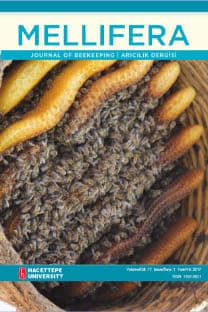Bursa'nın Narlıdere, Cumalıkızık ve Baraklı yörelerinden Apis mellifera L. tarafından toplanan polenlerin organoleptik analizi
Mayıs-Eylül 2001 'de Bursa 'nın Narlıdere, Cumahkızık ve Baraklı bölgelerinden toplanan polen örneklerinde organoleptik (renk, koku, tat) ve nişasta analizleri yapılmıştır. Her üç bölgeden toplanan polen örneklerinin renkleri %24,07 sarı ve tonlarında, %22,2 kahverengi ve tonlannda, %16,6 yeşil ve tonlarında, %16,6somon, %12,9 turuncu ve %7,4 diğer renklerde olduğu tespit edilmiştir. Çalışılan polenler koku bakımından değerlendirildiğinde % 11'inin en iyi puanı aldığı, %15'inin ise en kötü puanı aldığı saptanmıştır. Polenler tat bakımından değerlendirildiğinde ise %9'unun en iyi, %25'inin ise en kötü puanı aldığı görülmüştür. Oleaceae familyasından Ligustrum vulgare, Cucurbitaceae familyasından Cucumis spp., Chenopodiaceae familyasından Chenopodium albüm ve Fagaceae familyasından Castanea sauva polenleri, koku ve tat bakımından çalışılan tüm bölgelerde en iyi sonuç alman polenler olarak saptanmıştır. Polenlerin, %60'ında nişastaya rastlanılmazken, %40'ında nişasta saptanmıştır.
Organoleptical analysis of pollens collected by Apis mellifera L. in Cumalıkızık, Narlıdere and Baraklı areas of Bursa
Organoleptical (color, odor and taste) and starch analyses were conducted on pollen samples collected from Narhdere, Cumalikizik and Barakli areas in Bursa province from May to September 2001. It was observed that colors of pollen samples from these three areas were yellow and its tones by 24.07%, brown and its tones by 22.2%, green and its tones by 16.6%, salmon by 16,6%, orange by 12.9% and in other colors by 7.4%. Examining these pollens in terms of their odor, 11% got the highest possible grade while 15% were assigned lowest grades. The ranking of pollens by their taste is as follows: Best by 9% and worst by 25%. Pollens of Ligustrum vulgare from the family Oleaceae, Cucumis spp. from the family Cucurbitaceae, Chenopodium album from the family Chenopodiaceae and Castanea sativa from the family Fagaceae were the best in all three areas in terms of their odor and taste. While no starch was found in 60% of these pollen samples, the remaining 40% contained starch.
___
- 1. Dadant and Sons, The Hive and the Honeybee, A Dadant Publication, Dadant & Sons, Hamilton, Illionis, 740 p, 1976.
- 2. Sorkun, K., Inceoğlu, Ö., Pollen analysis of Central Anatolian Region, Doğa Bilim Dergisi, A 2,8,2,222-228 s, 1984a.
- 3. Crane, E., Honey, London, International Bee Research Association, 1978.
- 4. Crane, E., Bees: Honey and Pollen as Indicators of Metals in the Environment, Bee V^orjd, 65(1): 47-49 p, 1984.
- 5. Davis, P. H., Flora of Turkey and the East Aegean Islands, I-X, Edinburg University Press, Edinburg, 1965-1988.
- 6. Doğaroğlu, M., An Teknikleri Kitabı, Anadolu Matbaa & Ambalaj, İstanbul, 1999.
- 7. Sorkun, K., Polende Renk Çeşitliliği, Teknik Arıcılık, 77, 13-14 s, 2002.
- 8. Sorkun, K., Şahin, A., The Source of Starch Grains from Turkish Pine Honey, Journal of Apicultural Research, 39 (1-2): 85-86 p, 2000.
- 9. Bonvehi, S. J., Pajuelo, G. A., Galindo, G. J., Organoleptical Tests of Pollen Loads, Apiacta, 21: 15-20 p, 1986.
- 10. Bonvehi, J. S., Pajuelo, A. G., Evaluation of Honey Quality by Organoleptical Analysis, Apiacta, XXIII, 103-108 p, 1988.
- 11. Dafni, A., Pollination Ecology, A Practical Approach., Oxford Univ. Press, 250 p, 1992.
- 12. Gonnet, M., Judging the Quality of Honey by Sensory Analysis, 247-251, In Bee Products Properties, Applications and Apitherapy, Edith by Avshalom Mizrahi, Yaacov Lensky, 1997, Plenum Press, New York, 269 p, 1996.
- ISSN: 1302-5821
- Başlangıç: 2001
- Yayıncı: Hacettepe Üniversitesi
